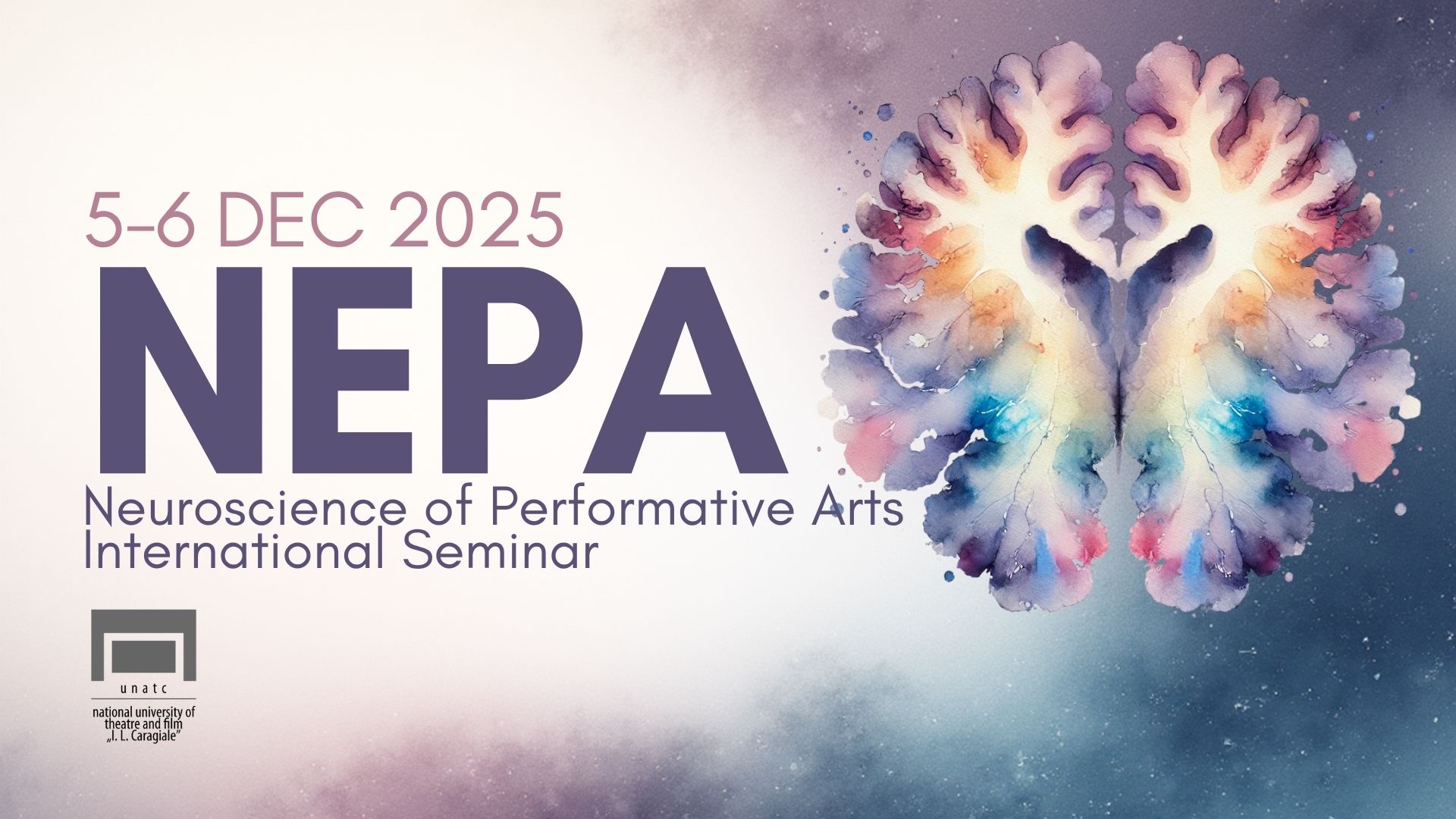NEPA – Neuroscience of Performative Arts International Seminar
5-6 December 2025 | Hybrid Seminar
The LDCAPEI Lab at UNATC is organizing the NEPA – Neuroscience of Performative Arts International Seminar on 5-6 December 2025, in a hybrid format.
The seminar has the objective to facilitate collaborations between performing arts practitioners, neuroscience researchers, psychologists and art therapists from performing arts fields to develop research aimed at increasing the understanding of the processes underlying performative representations.
In recent decades, there has been growing interest in using neuroscientific methods to explore art creation, practice, and participation at a biological level. In response to this, NEPA sets out to encourage knowledge exchange and to foster interdisciplinary collaborative research teams that bridge science and the performing arts.
Understanding core processes at the basis of performative representations at biophysiological levels will contribute to the development of performative practices and the efficacity of theatre, dance and music approaches for health, therapy and the development of more efficient teaching practices, as well as the understanding of their contribution to the development of the human society.
Building on the MET Project – Developing a Methodology of Therapy Through Theatre with Effects at the Neurochemical and Neurocognitive Levels, led by Ioana Carcea, UNATC has dedicated significant research to exploring fundamental aspects of theatre practice such as imitation, synchrony, autobiographical memory, role-play, and more recently, presence. Using the perspective of social neuroscience towards art practice brought fascinating data and results for theatre practices and its use in applied settings.
Selected Research and key findings from the LDCAPEI Lab
1. Berceanu, A. I., Papasteri, C., Sofonea, A., Boldasu, R., Niță, D., Poalelungi, C., Froemke, R., & Carcea, I. (2024). Oxytocin predicts positive affect gains in a role-play interaction. Frontiers in Psychology, 15, 1258254. https://doi.org/10.3389/fpsyg.2024.1258254
2. Tomescu, M. I., Papasteri, C., Sofonea, A., Berceanu, A. I., & Carcea, I. (2024). Personality moderates intra-individual variability in EEG microstates and spontaneous thoughts. Brain Topography. https://doi.org/10.1007/s10548-023-01019-x
3. Berceanu, A. I., Papasteri, C. C., Sofonea, A., Boldasu, R., Niță, D., Poalelungi, C., & Carcea, I. (2022). Role-play regulates positive emotions and prosocial attitudes. https://doi.org/10.31234/osf.io/r6cpn
4. Tomescu, M. I., Papasteri, C. C., Sofonea, A., Boldasu, R., Kebets, V., Pistol, C. A. D., Poalelungi, C., Benescu, V., Podina, I. R., Nedelcea, C. I., Berceanu, A. I., & Carcea, I. (2022). Spontaneous thought and microstate activity modulation by social imitation. NeuroImage. https://doi.org/10.1016/j.neuroimage.2022.118878
5. Cîrneci, D., Onu, M., Papasteri, C. C., Georgescu, D., Poalelungi, C., Sofonea, A., Pușcașu, N., Tănase, D., Rădeanu, T., Toader, M., Dogaru, A. L., Podină, I. R., Berceanu, A. I., & Carcea, I. (2022). Neural networks implicated in autobiographical memory training. eNeuro, 9(6), ENEURO.0137-22.2022. https://doi.org/10.1523/ENEURO.0137-22.2022
6. Berceanu, A. I., Macavei, B., & Matu, S. (2020). Emotional and cognitive responses to theatrical representations of aggressive behavior. In Performance in Theatre and Everyday Life: Cognitive, Neuronal, and Applied Aspects of Acting. Frontiers in Psychology. https://doi.org/10.3389/fpsyg.2020.01785
7. Papasteri, C., Sofonea, A. I., Boldasu, R., Poalelungi, C., Tomescu, M., Pistol, C. A. D., Vasilescu, R., Nedelcea, C., Podina, I., Berceanu, A. I., Froemke, R., & Carcea, I. (2020). Social feedback during sensorimotor synchronization changes salivary oxytocin and behavioral states. Frontiers in Psychology. https://doi.org/10.3389/fpsyg.2020.531046
NEPA
Nepa anophthalma is a small, blind water scorpion endemic to Movile Cave, Romania, living in an environment devoid of light and oxygen. The discovery of this remarkable creature was inspired by the work of Emil Racoviță, the pioneering Romanian biologist who studied how life evolves in isolated cave ecosystems. Similarly, the NEPA initiative views the performing arts as a living laboratory for studying the complexity of human communication, emotion, and representation of life, bringing neuroscientific and physiological research methods from the lab into the performative space.





